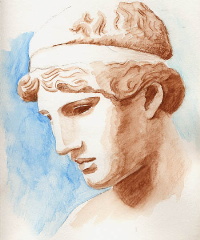Catchup 3: The Rule of Four
For those who liked The Da Vinci Code, another contemporary/Renaissance mystery.
The Rule of Four features a book written in 1499, and four friends at Princeton trying to decipher its many mysteries. Because beneath the surface tale are riddles, cyphers, clues and ultimately (of course) betrayals and treasures galore.
The book at the base of all the mystery is real:
It has been called the most beautiful book in the world, and the most unreadable. Its hero has sex with buildings. It also has a nearly unpronouncable title, "The Hypnerotomachia Poliphili." The book was published in Venice in 1499, and there are perhaps 260 copies in existence, among them one in the rare book library at Princeton University."The Hypnerotomachia" is written in many languages, including Greek, Latin, Hebrew, Arabic, Chaldean, Italian, invented words and hieroglyphics, and it was not even fully translated until 1999, when the first complete English edition appeared. No one is quite sure what it is about, or even who wrote it.
But now Ian Caldwell and Dustin Thomason, both 28 and best friends since the third grade, have written "The Rule of Four," a novel in which they have invented a solution to both mysteries. And though it is filled with esoteric Renaissance scholarship and initially put off publishers, "The Rule of Four" (Dial Press) is flying off the shelves.
...
In the real "Hypnerotomachia" this much is understood: a character, Poliphilo, dreams of his beloved Polia, and of his journeys in search of her. The title can be translated as "the struggle for love in a dream." Poliphilo has dreams within dreams, and when he has sex with buildings in at least one case his ecstasy is returned. The book is illustrated with exquisite woodcuts of the swooning hero and heroine, enchanted gardens, strange creatures, cherubs and nymphs.
The key to the true authorship of "The Hypnerotomachia" may lie hidden in the beautifully ornate letters at the beginning of each chapter, which spell out the words "Brother Francesco Colonna greatly loved Polia." There were two men with that name known at the time, one a Dominican monk in Venice, the other a Roman noble. There is also a theory that the book was written by the great Renaissance humanist and artist Leon Battista Alberti.
Quote is from NYT story about the 28-year-old authors, Ian Caldwell and Dustin Thomason, best friends since they were eight.
Compulsively readable, full of collegiate and renaissance lore, worth a sleepless night while you stay up to finish it.


0 Comments:
Post a Comment
<< Home